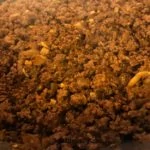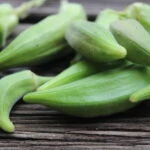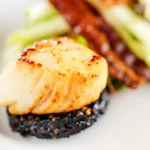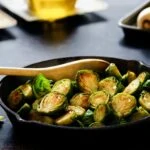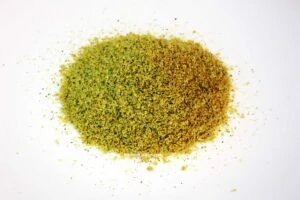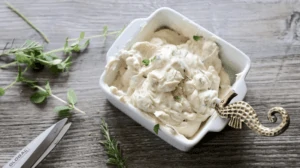I used to think chili powder was made from chili peppers. But what is a chili pepper? Are those the red ones? Well, I’ve figured it out. Chili powder is a lot more complex than I would have imagined, but not so complex to keep me from grinding my own. Here’s the low-down so you can include a new flavor in your cooking. Korean, or Indian chili powder? Is my new question.
What is Chili Powder Made Of?
It was a mystery for a long time, but I’ve figured it out.
Chili powder is usually a blend of various chilis that can include aleppo pepper, ancho chili, cayenne pepper, chipotle, chile de árbol, jalapeño, New Mexican chile, and piri piri chili peppers. Sometimes other spices are added, like onion, cumin, garlic, oregano, paprika, and occasionally salt.
Common Varieties of Chili Powder
Where do I begin? Chili powder differs depending on the cuisine.
The varieties of chili powder include
- Aleppo pepper from Syria.
- Ancho chili powder made from the Mexican poblano pepper.
- Piri piri powder, a tiny, extremely hot pepper that originated in Portugal and spread to Southern African territories.
- Indian chili powder made from red chilis.
- Gochugaro, a Korean chili powder made from long, low-spice, sweet green peppers.
Can I Make My Own Chili Powder?
Yes! Homemade chili powder is certainly easy to make.
Choose chilis based on your preferred flavor profile like sweet, smoky, or both, and level of spiciness.
First, clean chilis by removing their seeds and stems. Use a pair of clean kitchen shears and start by cutting off the stem. Next, snip along the length of the chili from top to tip, open it up, and scrape out the seeds and fibrous ribs with your fingers or a spoon.
Be sure to wear gloves for hot chilis, and don’t touch your face. Chilis can burn your skin depending on their level of spiciness. Remove your gloves carefully without touching the outsides with your bare skin.
Second, dry the chilis. This enhances the chili’s flavor, and prepares them for grinding into powder. The two best ways to dry chilis are in the oven or on the stove in a skillet.
Roasting in the oven is a good choice for a large quantity of chilis. To roast chilis in the oven, spread them on a baking sheet and place in an oven preheated to 350°F or 177°C. Turn the chilis occasionally so that they roast evenly. Chilis should turn golden-brown, or even black for a smokier flavor. When the chilis are done roasting, they will be pliable, very wrinkled, and have a strong roasted smell — this will take about three to five minutes.
Using a skillet to roast chilis is a good option if you don’t have many chilis. To roast chilis in a skillet, place them in a dry skillet over medium heat. Toss or turn them occasionally until they are roasted evenly on every side, pliable, and have a strong roasted smell, or about three to five minutes. Roast longer for a smokier flavor.
Chilis will puff up and likely burst from the pressure of steam that builds inside if roasted whole rather than being cleaned first.
After roasting chilis, make your own chili powder by grinding them in a blender or spice grinder. Add your choice of home-dried and ground, or pre-ground herbs like oregano, basil, paprika pepper, black pepper, and salt.
Use quantities to satisfy your taste. Don’t be afraid to get creative here! Taste your creation as you go by sprinkling a little on an egg, slice of cucumber, or mixing with hummus.
You can also make a flavorful chili paste by simmering your choice of cleaned chilis in water, vegetable or chicken stock until wilted, about 10 minutes. Use enough of your preferred liquid to cover the chilis.
Using a hand or standing blender, purée the cooked chilis with about one quarter ratio of the remaining liquid after cooking (for example, if you have one cup of chilis, add back 1/4 cup of liquid for a ratio of 1:1/4), and add salt and other spices to taste.
What Does Chili Powder Taste Like?
Chili powder offers a treasure chest of flavor, that varies depending on where it is made. Find the heat that makes you cry, or the sweetness that makes you lick your bowl.
Aleppo chili powder from Syria is used in Middles Eastern and Mediterranean cuisines. The Scoville scale* rates it at a moderate heat level (about 10,000 SHU). Its heat builds slowly among fruity, bright flavors of raisins and sun dried tomato.
Mexican Ancho chili powder is made from the dried and ground poblano pepper. Its flavor is mild, has low heat (1,000-1,500 SHU), though an occasional poblano can give turn out surprisingly spicy. Red poblanos are generally hotter and have more flavor than green poblanos.
Piri piri powder is traditional in Portugal and Southern African territories. It is made from an extremely hot (50,000-175,000 SHU), tiny red pepper that doesn’t have much flavor to mention due to its over-ruling heat. Piri piri is also used to make the South African piri piri sauce, a mix of chili, garlic, spirits, and spices like paprika, oregano, basil, and bay.
Indian chili powder made from the Thai, lal mirch chili, a red chili that is black-ish brown in color with a mild (1,000-2,000 SHU) heat.
Gochugaro Korean chili powder is low in spiciness (1,500 SHU), though can range to very hot. These chilis are traditionally sun-dried and ground into powder or flakes. The resultant, dried flavor is a complex artwork of smokey-sweetness.
*The Scoville scale rates the heat, or spiciness of foods using Scoville Heat Units (SHU), based on capsaicinoid concentration. The scale was created by and named after William Scoville, an American pharmacist, in 1912.
Where to Buy Chili Powder
Classic chili powder can be bought in regular grocery stores in the spice isle, or the vast variety, including gochugaro chili powder and Indian lal mirch chili powder can be found online or in specialty stores like Asian food markets.
[amazon table=”3390″]
How to Store Dry Spices
Though spices, especially ground, are best used within just a few months because they loose their fresh flavor quickly, they can be stored in a sealed container in a cupboard for 2 or 3 years at room temperature.
If you’ve made the above chili purée, store it in an air-tight container for one month in a fridge at 40°F or 4°C, or a freezer at 0°F or -17.78°C.
What is a Substitute for Chili Powder?
Since chili powder differs in flavor and heat between cuisines and chefs, and is easily home-made from a variety of herbs and peppers, I recommend making your own chili powder from the following dry ingredients, or following the recipe above to make it from whole peppers.
Some recommended chilis to use in the above recipe, or to purchase and mix already ground, include:
- Aleppo pepper (medium heat, fruity, cumin-y)
- Ancho chili (mild heat, slightly smoky)
- Cayenne pepper (hot, smoky taste)
- Chipotle (hotter than anchos, milder than chiles de árbol, smoky flavor)
- Chile de árbol (hot, grassy or nutty flavor)
- Jalapeño (medium heat, smoky and earthy flavor)
- New Mexican chili (hot, subtly sweet, crisp, smoky flavor)
- Piri piri chili peppers (very hot)
Some spices to consider include
- Onion powder
- Cumin powder
- Garlic powder
- Oregano powder
- Salt
Mix and match these ingredients and quantities of them as you like, depending on the cuisine you’re cooking for, the level of heat, and flavors.
Some common mixes include paprika, garlic, and chipotles for a smoky flavor. Sweet combinations generally include onion, aleppo, and piri piri.
Chili purée or paste: substitute approximately four times the amount of chili purée as you would chili powder (a ratio of 1:4). For example, if a recipe calls for one tablespoon of chili powder, use four tablespoons of chili purée instead.
Best Ways to Cook with Chili Powder
Many cuisines use chili powder, including Mexican, Indian, Korean, and classic Southern cooking. Here are some recommendations to get your exploration juices flowing.
- Mexican enchiladas or tacos: mix in with meat or sautéed bellpeppers, onions, and other veggies.
- Indian masala bell pepper curry using lal mirch peppers.
- Korean bibimbap sauce using gochugaro chili powder.
- A good-ole’ Louisiana bean chili and corn bread. Ask your aunt.
Whether you are grinding whole chilis or buying chili powder at the grocery store, you are sure to spice up your favorite dishes with a dash. If you haven’t tried some of the varieties listed here and are feeling adventurous, consider adding some to your next meal.

